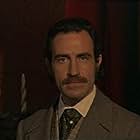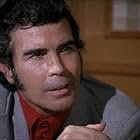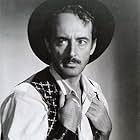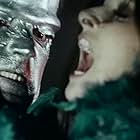IMDb RATING
4.8/10
30
YOUR RATING
A court-martialed soldier saves a fort and the Major who falsely testified against him from an Indian attack.A court-martialed soldier saves a fort and the Major who falsely testified against him from an Indian attack.A court-martialed soldier saves a fort and the Major who falsely testified against him from an Indian attack.
Photos
- Director
- Writers
- All cast & crew
- Production, box office & more at IMDbPro
Storyline
Did you know
- TriviaItalian censorship visa # 47328 delivered on 5 July 1966.
Featured review
Acceptable though middling tortilla Western dealing with ordinary labour of US cavalry while holding off hostile Indians . A court-martialed soldier saves a fort and the Major who falsely testified against him from an Indian attack . O'Hara (German Cobos) , cavalry officer , saves the fiancée (Marisa Pavan) of Brush (Mariano Vidal Molina) , his superior officer , a man who hates him from an Indian attack . Mary who has fallen in love with O'Hara embraces him . Brush on a peace mission to the Navajos instead attacks them , causing the Navajos and the Apaches to join forces . The Indians led by Red Feather (Rafael Albaicin) attack the fort commanded by Colonel Robert Patterson (Tomás Blanco) and Brush is mortally wounded and then admits his responsibility for the prior defeat , the reason of his enmity toward O'Hara .
Passable Chorizo Western with a professional Spanish filmmaker , B-actors , a lot of Spanish secondaries and expert technicians . All in all, this film is predominantly a Spanish film rather than an Italian one. It's a utterly Spanish Western , though by that time to be ordinary Spanish/Italian co-productions in which were clearly dominated by the Italian contingent and the traditional leanings of the Spanish producers of the time have their stamp on the entire proceedings . The Spanish westerns of this era were far more likely to try and emulate their American source material than cultivate a distinctive style of their own the way the Italians were doing but their product, if you like traditional westerns remains watchable . Customary Western that doesn't follows the Sergio Leone wake , but it is proceeded in American models . It's an exciting western with breathtaking shootouts and facing off between cavalry and Indians .
The picture is set at the end of the Civil War (1861-1865) where a motley band Union soldiers clashes with a bunch of Indians and free a captive . The film packs action , thrills , high body-count and turns out to be fast moving and quite entertaining . There is plenty of action in the movie , guaranteeing some shoot'em up , go riding or stunts every few minutes . The sense of pacing is such that this film can be counted on to move quickly and smoothly . There is a very odd implementation of shots in the camera work during some particular scenes as the film approaches its climax , as in the final gunfights full of cavalry raid , shots and Indian attacks on the fort . Outdoor sequences with barren and rocky exteriors filmed in Spanish places located on Manzanares Del Real , Seseña , Colmenar Viejo (Madrid) and Almeria that resulted to be the locations in which were shot lots of Western produced and directed by Spanish people . The film is well starred by German Cobos and Mariano Vidal Molina . Cobos played a lot of Paella/Chorizo or Tortilla Western filmed in Spain such as : ¨Hombre De La Diligencia¨ by Jose Maria Elorrieta¨, ¨Fuerte Perdido¨, ¨Valor De Cobarde¨ by Leon Klimowsky , ¨Wanted¨ by Giorgo Ferroni , ¨Blood calls to Blood¨ by Luigi Capuano . There appears as ordinary secondaries in Spanish/Italian Western such Jose Canalejas , Rafael Albaicín , Rafael Hernández , Alfonso de la Vega , Angel Ter , Fernando Bilbao and habitual Frank Braña as a Comanchero who carries out weapon smuggling to Indians , and a splendid Tomas Blanco, in the character of fort commandant overwhelmed by the weight of guilt and illness , among others .
Colorful as well as evocative cinematography in Eastmancolor by Alfonso Nieva , though being necessary a right remastering . Atmospheric and lively musical score by Manuel Moreno . Being professionally directed by Arturo Ruiz Del Castillo , but mediocre . Arturo Ruiz Castillo is generally considered to be a decent director . He made several shorts and documentaries and directed all kind of genres . As he filmed autobiography about a player, Kubala , : ¨Los Ases Buscan La Paz¨, Historical : Catalina La Grande¨ , Drama : ¨Las Inquietudes De Shanti Andía¨, ¨Culpables¨, ¨Llovidos Del Cielo¨ , ¨Dos Caminos¨, ¨Pachin¨ and one Western . His most known picture was ¨La Laguna Negra¨ a film adaptation of a poem by Antonio Machado, "La Tierra De Alvargonzález" included in what is considered his best work, "Campos De Castilla ; furthermore , ¨El Santuario No Se Rinde¨ about a heroic event during the Spanish Civil War .
Passable Chorizo Western with a professional Spanish filmmaker , B-actors , a lot of Spanish secondaries and expert technicians . All in all, this film is predominantly a Spanish film rather than an Italian one. It's a utterly Spanish Western , though by that time to be ordinary Spanish/Italian co-productions in which were clearly dominated by the Italian contingent and the traditional leanings of the Spanish producers of the time have their stamp on the entire proceedings . The Spanish westerns of this era were far more likely to try and emulate their American source material than cultivate a distinctive style of their own the way the Italians were doing but their product, if you like traditional westerns remains watchable . Customary Western that doesn't follows the Sergio Leone wake , but it is proceeded in American models . It's an exciting western with breathtaking shootouts and facing off between cavalry and Indians .
The picture is set at the end of the Civil War (1861-1865) where a motley band Union soldiers clashes with a bunch of Indians and free a captive . The film packs action , thrills , high body-count and turns out to be fast moving and quite entertaining . There is plenty of action in the movie , guaranteeing some shoot'em up , go riding or stunts every few minutes . The sense of pacing is such that this film can be counted on to move quickly and smoothly . There is a very odd implementation of shots in the camera work during some particular scenes as the film approaches its climax , as in the final gunfights full of cavalry raid , shots and Indian attacks on the fort . Outdoor sequences with barren and rocky exteriors filmed in Spanish places located on Manzanares Del Real , Seseña , Colmenar Viejo (Madrid) and Almeria that resulted to be the locations in which were shot lots of Western produced and directed by Spanish people . The film is well starred by German Cobos and Mariano Vidal Molina . Cobos played a lot of Paella/Chorizo or Tortilla Western filmed in Spain such as : ¨Hombre De La Diligencia¨ by Jose Maria Elorrieta¨, ¨Fuerte Perdido¨, ¨Valor De Cobarde¨ by Leon Klimowsky , ¨Wanted¨ by Giorgo Ferroni , ¨Blood calls to Blood¨ by Luigi Capuano . There appears as ordinary secondaries in Spanish/Italian Western such Jose Canalejas , Rafael Albaicín , Rafael Hernández , Alfonso de la Vega , Angel Ter , Fernando Bilbao and habitual Frank Braña as a Comanchero who carries out weapon smuggling to Indians , and a splendid Tomas Blanco, in the character of fort commandant overwhelmed by the weight of guilt and illness , among others .
Colorful as well as evocative cinematography in Eastmancolor by Alfonso Nieva , though being necessary a right remastering . Atmospheric and lively musical score by Manuel Moreno . Being professionally directed by Arturo Ruiz Del Castillo , but mediocre . Arturo Ruiz Castillo is generally considered to be a decent director . He made several shorts and documentaries and directed all kind of genres . As he filmed autobiography about a player, Kubala , : ¨Los Ases Buscan La Paz¨, Historical : Catalina La Grande¨ , Drama : ¨Las Inquietudes De Shanti Andía¨, ¨Culpables¨, ¨Llovidos Del Cielo¨ , ¨Dos Caminos¨, ¨Pachin¨ and one Western . His most known picture was ¨La Laguna Negra¨ a film adaptation of a poem by Antonio Machado, "La Tierra De Alvargonzález" included in what is considered his best work, "Campos De Castilla ; furthermore , ¨El Santuario No Se Rinde¨ about a heroic event during the Spanish Civil War .
Details
- Release date
- Country of origin
- Language
- Also known as
- El secreto del capitán O'Hara
- Production company
- See more company credits at IMDbPro
- Runtime1 hour 39 minutes
- Color
- Aspect ratio
- 2.35 : 1
Contribute to this page
Suggest an edit or add missing content

Top Gap
By what name was Secret of Captain O'Hara (1966) officially released in Canada in English?
Answer










